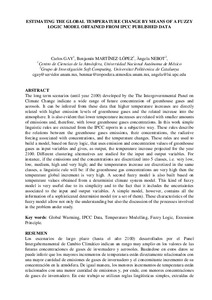Por favor, use este identificador para citar o enlazar este ítem:
http://hdl.handle.net/20.500.11765/8667
Estimating the global temperature change by means of a fuzzy logic model obtained from IPCC published data
Registro completo de metadatos
| Campo DC | Valor | Lengua/Idioma |
|---|---|---|
| dc.contributor.author | Gay, Carlos | es_ES |
| dc.contributor.author | Martínez López, Benjamín | es_ES |
| dc.contributor.author | Nebot, Àngela | es_ES |
| dc.date.accessioned | 2018-03-02T10:09:43Z | - |
| dc.date.available | 2018-03-02T10:09:43Z | - |
| dc.date.issued | 2008 | - |
| dc.identifier.citation | Sigró Rodríguez, J.; Brunet India, M.; Aguilar Anfrons, E. (eds.). Cambio climático regional y sus impactos. Tarragona: Asociación Española de Climatología, 2008, p. 543-551 | es_ES |
| dc.identifier.isbn | 978-84-612-6051-5 | - |
| dc.identifier.uri | http://hdl.handle.net/20.500.11765/8667 | - |
| dc.description | Ponencia presentada en: VI Congreso Internacional de la Asociación Española de Climatología celebrado en Tarragona del 8 al 11 de octubre de 2008. | es_ES |
| dc.description.abstract | [EN]The long term scenarios (until year 2100) developed by the The Intergovernmental Panel on Climate Change indicate a wide range of future concentration of greenhouse gases and aerosols. It can be inferred from these data that higher temperature increases are directly related with higher emission levels of greenhouse gases and the related increase into the atmosphere. It is also evident that lower temperature increases are related with smaller amounts of emissions and, therefore, with lower greenhouse gases concentrations. In this work simple linguistic rules are extracted from the IPCC reports in a subjective way. These rules describe the relations between the greenhouse gases emissions, their concentrations, the radiative forcing associated with concentrations, and the temperature changes. | es_ES |
| dc.description.abstract | [ES]Los escenarios de largo plazo (hasta el año 2100) desarrollados por el Panel Intergubernamental de Cambio Climático indican un rango muy amplio en los valores de las futuras concentraciones de gases de invernadero y aerosoles. Basándose en estos datos se puede inferir que los mayores incrementos de temperatura están directamente relacionados con una mayor cantidad de emisiones de gases de invernadero y el concomitante incremento de su concentración en la atmósfera. De igual manera, los menores incrementos de temperatura están relacionados con una menor cantidad de emisiones y, por ende, con menores concentraciones de gases de invernadero. En este trabajo se utilizan reglas lingüísticas simples, extraídas de manera subjetiva de los reportes de IPCC, que describen las relaciones entre las emisiones de gases de invernadero, sus concentraciones, los forzamientos radiativos asociados a estas concentraciones y los cambios de temperatura. | es_ES |
| dc.language.iso | eng | es_ES |
| dc.publisher | Asociación Española de Climatología | es_ES |
| dc.relation.ispartofseries | Publicaciones de la Asociación Española de Climatología. Serie A;6 | - |
| dc.rights | Licencia CC: Reconocimiento–NoComercial–SinObraDerivada CC BY-NC-ND | es_ES |
| dc.subject | Global warming | es_ES |
| dc.subject | IPCC Data | es_ES |
| dc.subject | Temperature modelling | es_ES |
| dc.subject | Fuzzy logic | es_ES |
| dc.subject | Calentamiento global | es_ES |
| dc.subject | Modelado del clima | es_ES |
| dc.subject | Lógica difusa | es_ES |
| dc.subject | Principio de extensión | es_ES |
| dc.title | Estimating the global temperature change by means of a fuzzy logic model obtained from IPCC published data | es_ES |
| dc.type | info:eu-repo/semantics/conferenceObject | es_ES |
| dc.rights.accessRights | info:eu-repo/semantics/openAccess | es_ES |
| Colecciones: | (2008, Tarragona). VI Congreso AEC | |
Ficheros en este ítem:
| Fichero | Descripción | Tamaño | Formato | ||
|---|---|---|---|---|---|
| 0051_VI-2008-GAY.pdf | 596,96 kB | Adobe PDF |  Visualizar/Abrir |
Los ítems de Arcimis están protegidos por una Licencia Creative Commons, salvo que se indique lo contrario.





